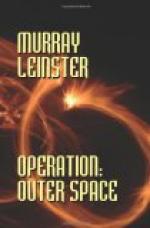He went happily down the stairs again. This was a spiral stair, and he zestfully spun around it as he went to the next deck below. At the bottom he called up to Babs:
“Babs! Get Bell and Alicia Keith and come along to take dictation! I’m going to need some legal witnesses for the biggest deal in the history of advertising, made at several times the speed of light!”
And he went zestfully to the communicator to set it up.
And time passed. Data arrived, which at once solved Jones’ and the pilot’s problem of where they were and how far they had come—it was, actually, 178.3 light-years—and they spent an hour making further tests and getting further determinations, and then they got a destination.
They stopped in space to extrude from the airlock a small package which expanded into a forty-foot plastic balloon with a minute atomic battery attached to it. The plastic was an electric conductor. It was a field-plate of the Dabney field. It took over the field from Earth and maintained it. It provided a second field for the ship to maintain. The ship, then, could move at any angle from the balloon. The Dabney field stretched 178.3 light-years through emptiness to the balloon, and then at any desired direction to the ship.
The ship’s rockets thrust again—and the booster-circuit came into play. There were maneuverings. A second balloon was put out in space.
At 8:30 Central U. S. Time, on a period relinquished by other advertisers—bought out—a new program went on the air. It was a half-hour show, sponsored by the Intercity Credit Corporation—“Buy on Credit Guaranteed”—with ten straight minutes of commercials interjected in four sections. It was the highest-priced show ever put on the air. It showed the interior of the ship’s control-rooms, with occasional brief switches to authoritative persons on Earth for comment on what was relayed from the far-off skies.
The first broadcast ensured the success of the program beyond possible dispute. It started with curt conversation between Jones and the pilot, Al—Jones loathed this part of it, but Al turned out to be something of a ham—on the problems of approaching a new solar system. Cut to computers back on Earth. Back to the control-room of the starship. Pictures of the local sun, and comments on its differentness from the sun that had nourished the human race since time began.
Then the cameras—Bell worked them—panned down through the ship’s blister-ports. There was a planet below. The ship descended toward it. It swelled visibly as the space-ship approached. Cochrane stood out of camera-range and acted as director as well as producer of the opus. He used even Johnny Simms as an offstage voice repeating stern commands. It was corny. There was no doubt about it. It had a large content of ham.
But it happened to be authentic. The ship had reached another planet, with vast ice-caps and what appeared to be no more than a twenty-degree-wide equatorial belt where there was less than complete glaciation. The rockets roared and boomed as the ship let down into the cloud-layers.




